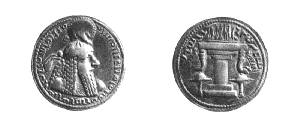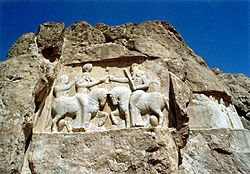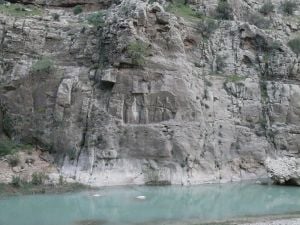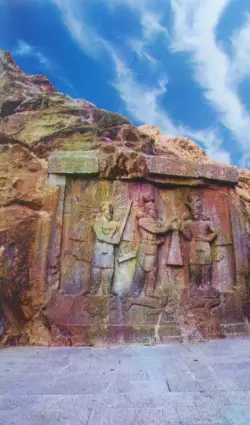Ardashir I
| Ardeshir I | ||
|---|---|---|
| Shahanshah, King of Kings of Iran | ||

| ||
| Successor | Shapur I | |
| Father | Babak | |
Ardashir I, founder of the Sassanid Empire, was ruler of Istakhr (206-241), subsequently of what roughly corresponds to Persia (208-241), and finally "King of Kings of Iran" (226-241). The dynasty Ardashir founded would rule for four centuries, defeat the Roman several times, resist their attempts to inflict revenge and survive until finally overthrown by the Muslim Caliphate in 651. The Sassanid era, which Ardashir I inaugurated, is considered one of Iran's most important and influential historical periods. In many ways, the Sassanid period witnessed the highest achievement of Persian civilization, constituting the last great Iranian Empire before the Muslim conquest.
Sassanid cultural influence extended far beyond the empire's territorial borders, reaching Western Europe, Africa, China and India and played a prominent role in the formation of European and Asiatic medieval art. Ardashir I's empire became a vital cultural catalyst, profoundly enriching human life. Often tolerant of religious minorities, Jewish life would especially flourish during the Sassanid period, producing the Babylonian Talmud. Rome would learn to respect the Sassanids as they perhaps respected no other people, due in no small measure to the defeats they suffered at the hands of Ardashir and of his son, Shapur I. In an increasingly inter-dependent world, humanity will benefit most when people learn to value all cultures, to rejoice in the technical achievements of all people, to regard humanity as one family, instead of restricting "human" to those whose image and beliefs mirror their own. The Romans often did just this but they could not deny the accomplishments, the valor, skill and abilities and of the empire Ardashi founded, which his heirs were still ruling when ancient Rome had fallen.
Name
Ardashir (Arđaxšēr from Middle Persian and Parthian Artaxšaθra, Pahlavi ʼrthštr, "Who has the Divine Order as his Kingdom") is also known as Ardashīr-i Pāpagān "Ardashir, son of Pāpağ," and other variants of his name include Latinized Artaxares and Artaxerxes.

Early years

Ardashir was born in the late second century in Istakhr, what is present-day Fars in Iran, then a vassal kingdom of the Parthian Arsacids. According to one tradition, he inherited the throne of Istakhr from his father Pāpağ (sometimes written as Pāpak or Babak) who had deposed the previous king Gochihr to gain the throne for himself. His mother may have been named Rodhagh. Prior to succeeding his father, Ardashir is said to have ruled the town of Darabgerd and received the title of "argbadh." Upon Pāpağ's death, Ardashir's elder brother Šāpūr ascended to the throne. However, Ardashir rebelled against his brother and took the kingship for himself in 208.
Most scholars have assumed that Ardeshir's father was Papak, a vassal king, and his grandfather was Sasan. However, there is another theory of his lineage, which is found in the Middle Persian book Kārnāmag-ī Ardaxšīr-ī Pābagān (Book of Deeds of Ardeshir Son of Papak) written 224-651 C.E.[1]This story is later confirmed by Ferdowsi's Shahnameh. This theory suggests that Sasan married the daughter of Papak after the latter discovers that Sasan is of royal Achaemenid descent. Hence Ardeshir was born. From here onwards Sasan disappears from the story and Papak is considered the father. Ardeshir helped Papak conquer some parts of Fars. It is possible that after Papak's death, his son Shapur, had a short reign which was probably ended by an accidental death. Around 216 Ardeshir became ruler of Papak's kingdom, which was confined to central Fars. Soon he extended his realm into Kerman to the east and Elymais to the west.[2]
After this Artabanus V ordered the ruler of Khuzestan to confront Ardeshir, but he was defeated in battle. In 226 Artabanus V invaded Fars to defeat Ardeshir, his rebellious vassal. Ardeshir won the first battle, but with heavy losses on both sides. In the second battle the Parthians suffered a greater loss and Ardeshir won again. The final battle fought between Ardeshir and Artabanus was fought in Hormuz, near the modern city of Bandar Abbas. In this battle the Parthian army was completely defeated and Artabanus was killed. According to one account, Ardeshir and Artabanus fought in close combat on horseback. Ardeshir pretended to flee, turned around in the saddle and shot Artabanus through the heart.[3]
Ardashir rapidly extended his territory, demanding fealty from the local princes of Fars and gaining control over the neighboring provinces of Kerman, Isfahan, Susiana, and Mesene. This expansion brought the attention of the Arsacid Great King Ardavan (Artabanus) IV (216–224), Ardashir's overlord and ruler of the Parthian Empire, who marched against him in 224. Their armies clashed at Hormizdeghan, and Artabanus IV was killed. According to the hagiographic Book of the Deeds of Ardashir son of Babak, Ardashir I then went on to capture the western vassal states of the now-defunct Arsacids.
Crowned in 226 as the Šāhān šāh Ērān "king of kings [of] Iran" (his consort Adhur-Anahid took the title "Queen of Queens"), Ardashir finally brought the 480 year-old Parthian Empire to an end and began four centuries of Sassanid rule.
Over the next few years, Ardashir I further expanded his new empire to the east and northwest, conquering the provinces of Sistan, Gorgan, Khorasan, Margiana (in modern Turkmenistan), Balkh, and Chorasmia. Bahrain and Mosul were also added to Sassanid possessions. Furthermore, the Kings of Kushan, Turan, and Mekran recognized Ardashir as their overlord. In the West, assaults against Hatra, Armenia and Adiabene met with less success.
Religion and state
According to historian Arthur Christensen, the Sassanid state as established by Ardashir I was characterized by two general trends which differentiated it from its Parthian predecessor: a strong political centralization and organized state sponsorship of Zoroastrianism.
The Parthian Empire had consisted of a loose federation of vassal kingdoms under the suzerainty of the Arsacid monarchs. In contrast, Ardashir I established a strong central government by which to rule his dominions. The empire was divided into cantons, the dimensions of which were based on military considerations. These cantons were designed to resist the influence of hereditary interests and feudal rivalries. Local governors who descended from the ruling family bore the title of shāh. In an attempt to protect royal authority from regional challenges, the personal domains of the Sassanids and branch families family were scattered across the empire. While the old feudal princes (vāspuhragan) remained, they were required to render military service with their local troops (for the most part peasant levies). The lesser nobility was cultivated as a source of military strength, forming the elite cavalry of the army, and the royal household found a useful (and presumably reliable) military force through the hiring of mercenaries.
Zoroastrianism had existed in the Parthian Empire, and—according to tradition—its sacred literature had been collated during that era. Similarly, the Sassanids traced their heritage to the Temple of Anahita at Staxr, where Ardashir I's grandfather had been a dignitary. Under Ardashir however, Zoroastrianism was promoted and regulated by the state, one based on the ideological principle of divinely granted and indisputable authority. The Sassanids built fire temples and, under royal direction, an (apparently) "orthodox" version of the Avesta was compiled by a cleric named Tansār, and it was during the early period that the texts as they exist today were written down (until then these were orally transmitted). In the western provinces, a Zurvanite doctrine of the religion with Time as the First Principle appears to have competed with the Mazdaen form (as it is known from the Sassanid prototype of the Avesta).
In other domestic affairs, Ardashir I maintained his familial base in Fars, erecting such structures as the Ghal'eh Dokhtar ("The Maiden Castle") and the Palace of Ardashir. Despite these impressive structures, he established his government at the old Arsacid capital of Ctesiphon on the Tigris River. He also rebuilt the city of Seleucia, located just across the river, which had been destroyed by the Romans in 165, renaming it Veh-Ardashir. Trade was promoted and important ports at Mesene and Charax were repaired or constructed.

War with Rome
In the latter years of his reign, Ardashir I engaged in a series of armed conflicts with Persia's great rival to the west – the Roman Empire.
Ardashir I's expansionist tendencies had been frustrated by his failed invasions of Armenia, where a branch of the Arsacids still occupied the throne. Given Armenia's traditional position as an ally of the Romans, Ardashir I may have seen his primary opponent not in the Armenian and Caucasian troops he had faced, but in Rome and her legions.

In 230 Ardashir I led his army into the Roman province of Mesopotamia, unsuccessfully besieging the fortress town of Nisibis. At the same time, his cavalry ranged far enough past the Roman border to threaten Syria and Cappadocia. It seems that the Romans saw fit to attempt a diplomatic solution to the crisis, reminding the Persians of the superiority of Roman arms, but to no avail. Ardashir I campaigned unsuccessfully against Roman border outposts again the following year (231). As a result, the Roman emperor Alexander Severus (222–235) moved to the east, establishing his headquarters at Antioch, but experienced difficulties in bringing his troops together and thus made another attempt at diplomacy, which Ardashir I rebuffed.
Finally, in 232, Severus led his legions in a three-pronged assault on the Persians. However, the separate army groups did not advance in a coordinated fashion, and Ardashir was able to take advantage of the disorder and concentrate his forces against the enemy advancing through Armenia, where he was able to halt the Roman advance. Hearing of the Roman plans to march on his capital at Ctesiphon, Ardashir left only a token screening force in the north and met the enemy force that was advancing to the south, apparently defeating it in a decisive manner. However, one can discern that the Persians must have suffered considerable losses as well, as no attempt was made to pursue the fleeing Romans. Both leaders must have had reason to avoid further campaigning, as Severus returned to Europe in the following year (233) and Ardashir did not renew his attacks for several years, probably focusing his energies in the east.
In 237, Ardashir—along with his son and successor Shapur I (241–272)—again invaded Mesopotamia. The successful assaults on Nisibis and Carrhae and the shock this caused in Rome led the emperor to revive the Roman client-state of Osroene. In 241, Ardashir I and Shapur finally overcame the stubborn fortress of Hatra. Ardashir I died later in the year.
Legacy
The Kārnāmag-ī Ardaxšīr-ī Pābagān (Book of the Deeds of Ardashir) is a semi-legendary story of Ardashir, childhood, youth and rise to power. It continues with the lives of Shapur I and of his son, Hormizd I.[4] He is also featured in Ferdowsi's Book of Kings. Ardashir I was an energetic king, responsible for the resurgence not just of Persia but of Iranian-speaking peoples as a unified nation (ethnous as it appears in the Greek version of his successor's inscription on the Ka'ba-ye Zardosht), the strengthening of Zoroastrianism, and the establishment of a dynasty that would endure for four centuries. While his campaigns against Rome met with only limited success, he achieved more against them than the Parthians had done in many decades and prepared the way for the substantial successes his son and successor Shapur I would enjoy against the same enemy.
His son was an able successor, who consolidated on his father's legacy. Relatively few sons have succeeded in building as competently and skillfully on the foundation laid by their fathers. In many respects, the two men - father and son - co-founded the great Sassanid Empire. Shapur famously defeated, captured and humiliated Emperor Valerian in 260, having earlier. The Empire went on to resist Rome, to earn the almost unique respect of the Romans, who borrowed some of the Sassanid military tactics. The Empire of which Shapur was the second ruler, who did much to shape its future, would resist Rome, surviving longer than the Western Roman Empire. It fell to the Muslims to finally defeat the Sassanids. Shapur I was one of a handful of men who inflicted a defeat on Rome that was never avenged.
The fact that Shapur was one of the very few men who humiliated the Romans may represent a positive historical legacy. This reminds the world that no single civilization can claim to be superior to all others; in fact, Rome owed a considerable debt to the Sassanids; In a modified form, the Roman Imperial autocracy imitated the royal ceremonies of the Sassanid court. These, in turn, had an influence on the ceremonial traditions of the courts of modern Europe. The origin of the formalities of European diplomacy is attributed to the diplomatic relations between the Persian and Roman Empires.[5] In an increasingly inter-dependent world, humanity will benefit most when people learn to value all cultures, to rejoice in the technical achievements of all people and to regard humanity as one family, instead of restricting "human" to those who belong to my nation, race, religion or who identify with my ideology or philosophy or worldview.
| Sassanid dynasty | ||
|---|---|---|
| Preceded by: (new founding) |
"King of Kings of Iran" 226 – 241 |
Succeeded by: Shapur I |
Notes
- ↑ Book of Deeds of Ardeshir son of Papak, Charles F. Horne, ed., (in English). CAIS. Retrieved February 25, 2009.
- ↑ Ehsan Yarshater. 1983. The Cambridge history of Iran. Vol.3, The Seleucid, Parthian and Sasanian periods. (Cambridge, UK: Cambridge University Press. ISBN 9780521200929), 116-118.
- ↑ Percy Molesworth Sykes. 2004. A history of Persia. (London, UK: Routledge Curzon. ISBN 9780415326780), 394.
- ↑ Ahmad Hasan Dani, et al. 1999. History of civilizations of Central Asia. (Delhi, IN: Motilal Banarsidass. ISBN 9788120814097), 96.
- ↑ J.B. Bury. 1923. History Of The Later Roman Empire. (London, UK: Macmillan), 109. online, History Of The Later Roman Empire. Penelope at Univ. of Chicago. Retrieved February 25, 2009.
ReferencesISBN links support NWE through referral fees
- Book of Deeds of Ardeshir Son of Papak. written 224-651 C.E. Book of Deeds of Ardeshir son of Papak, Charles F. Horne, ed., (in English). CAIS. Retrieved February 25, 2009
- Bury, J.B. 1923. History Of The Later Roman Empire. London, UK: Macmillan. online, History Of The Later Roman Empire. Penelope at Univ. of Chicago. Retrieved February 25, 2009.
- Dani, Ahmad Hasan, et al. 1999. History of civilizations of Central Asia. Delhi, IN: Motilal Banarsidass. ISBN 9788120814097.
- Ferdowsi. Shahnameh (Book of Kings or Epic of Kings) manuscript ca. 1000 C.E. (in Persian, translated from Pahlavi and other languages)
- Ferdowsi, Abolqasem, Dick Davis translation into modern English. 2006., Shahnameh: The Persian Book of Kings. New York: Viking Adult. ISBN 0670034851.
- Robinson, B.W., Abū al-Qāsim Ḥasan Firdawsī, and Arthur George Warner. 2002. The Persian book of kings: an epitome of the Shahnama of Firdawsi. London, UK: Routledge Curzon. ISBN 9780700716180.
- Sykes, Percy Molesworth. 2004. A history of Persia. London, UK: Routledge Curzon. ISBN 9780415326780.
- Yarshater, Ehsan. 1983. The Cambridge history of Iran. Vol.3, The Seleucid, Parthian and Sasanian periods. Cambridge, UK: Cambridge University Press. ISBN 9780521200929.
Credits
New World Encyclopedia writers and editors rewrote and completed the Wikipedia article in accordance with New World Encyclopedia standards. This article abides by terms of the Creative Commons CC-by-sa 3.0 License (CC-by-sa), which may be used and disseminated with proper attribution. Credit is due under the terms of this license that can reference both the New World Encyclopedia contributors and the selfless volunteer contributors of the Wikimedia Foundation. To cite this article click here for a list of acceptable citing formats.The history of earlier contributions by wikipedians is accessible to researchers here:
The history of this article since it was imported to New World Encyclopedia:
Note: Some restrictions may apply to use of individual images which are separately licensed.
